Abstract
This paper summarizes the available information on the relationship of two envelope antigens (haemagglutinin and neuraminidase) of influenzaviruses isolated from different hosts. The relationship of the haemagglutinin antigens was based on the results of haemagglutination inhibition tests with postinfection sera and that of the neuraminidase antigens on the results of neuraminidase inhibition and gel precipitation tests with hyperimmune and monospecific sera. On the basis of the antigenic specificity of the haemagglutinin, the influenzaviruses of human origin are divided into several subtypes (H0, H1, H2); viruses of equine origin could be divided into two subtypes (Heq1, Heq2). Porcine influenza strains are regarded as belonging to a single subtype, all of them being related to the prototype swine influenzavirus A (swine/Iowa/15/30). Within the avian influenzaviruses, 6 antigenic subtypes were described in earlier studies. Antigenic relationships between the haemagglutinin of strains from different hosts were infrequent but were demonstrated and confirmed between human A/Hong Kong/68 and equine viruses and between A/Hong Kong/68 and swine/Taiwan/69. The swine/Taiwan/69 virus also shared the related neuraminidase with A/Hong Kong/68 virus, and represents the only isolation from nonhuman sources of an influenzavirus identical with a human pandemic strain. The studies on the antigenic specificity of the neuraminidases demonstrated 8 antigenic varieties of neuraminidase among avian influenzaviruses and also that the neuraminidase grouping did not correspond with the antigenic grouping with regard to haemagglutinin. The relationships between human and nonhuman influenzaviruses are emphasized because of their significance to studies on the origin of influenza pandemics in man.
Full text
PDF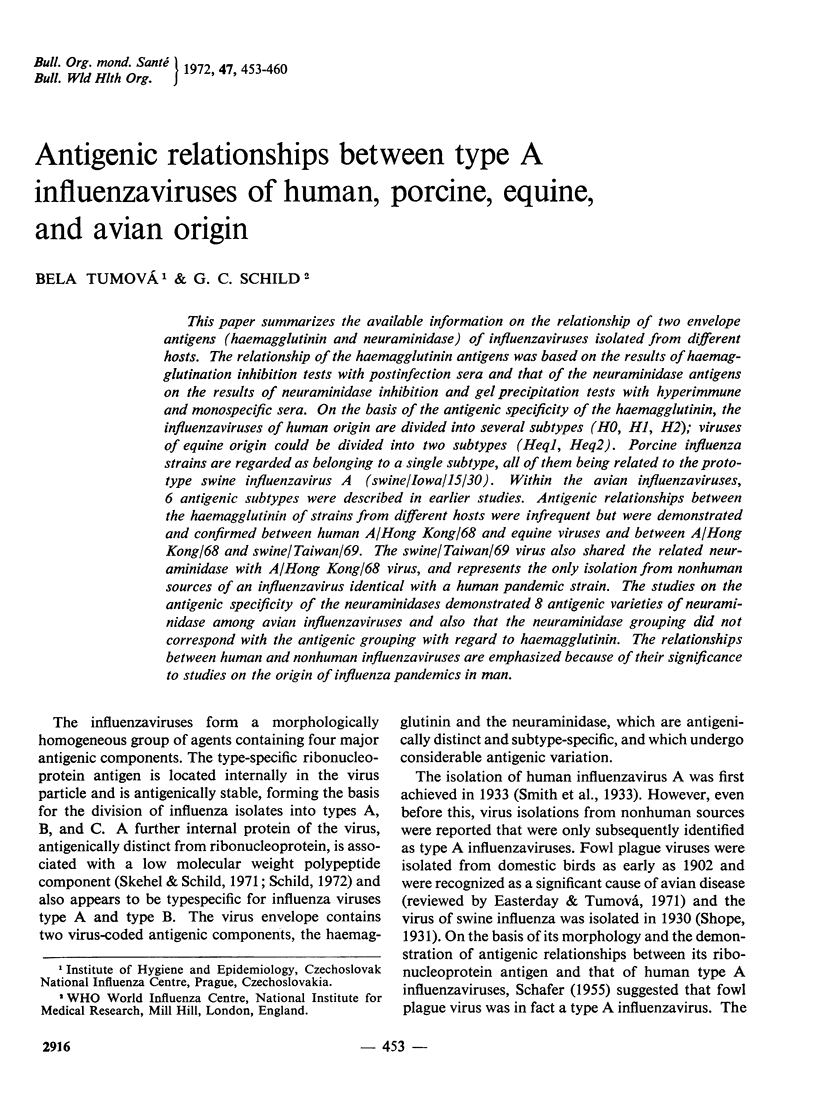
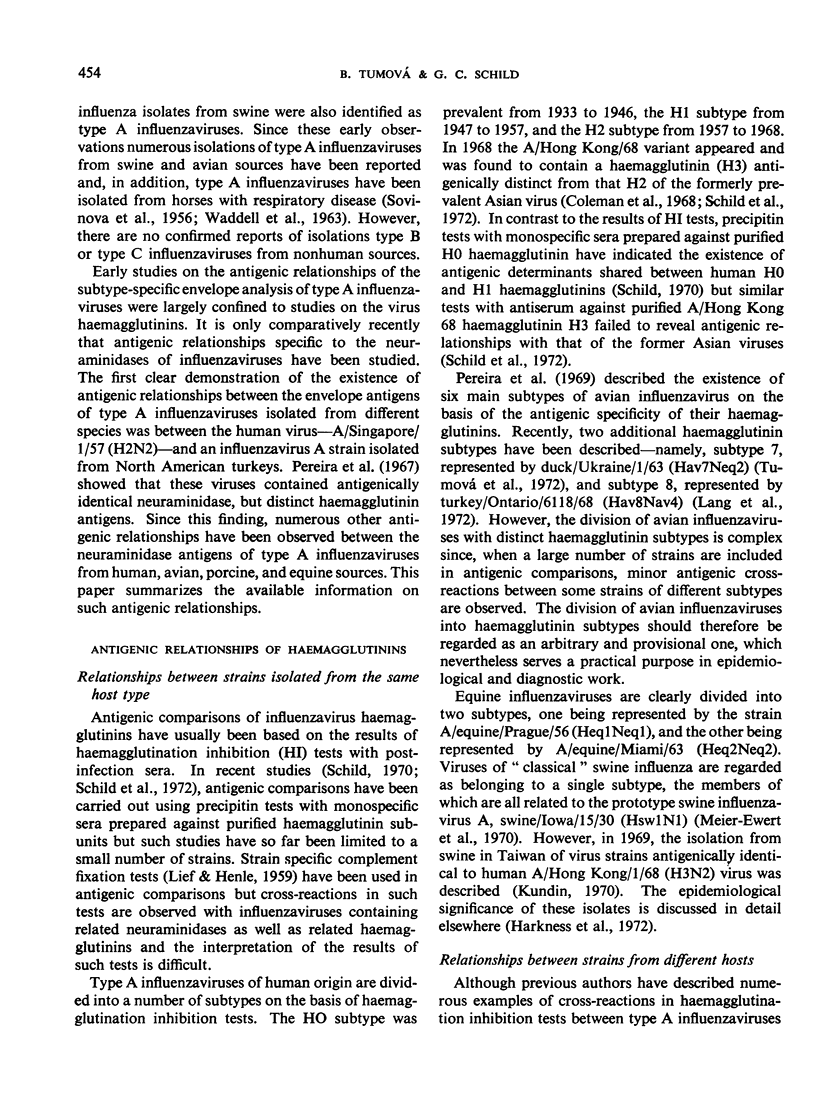
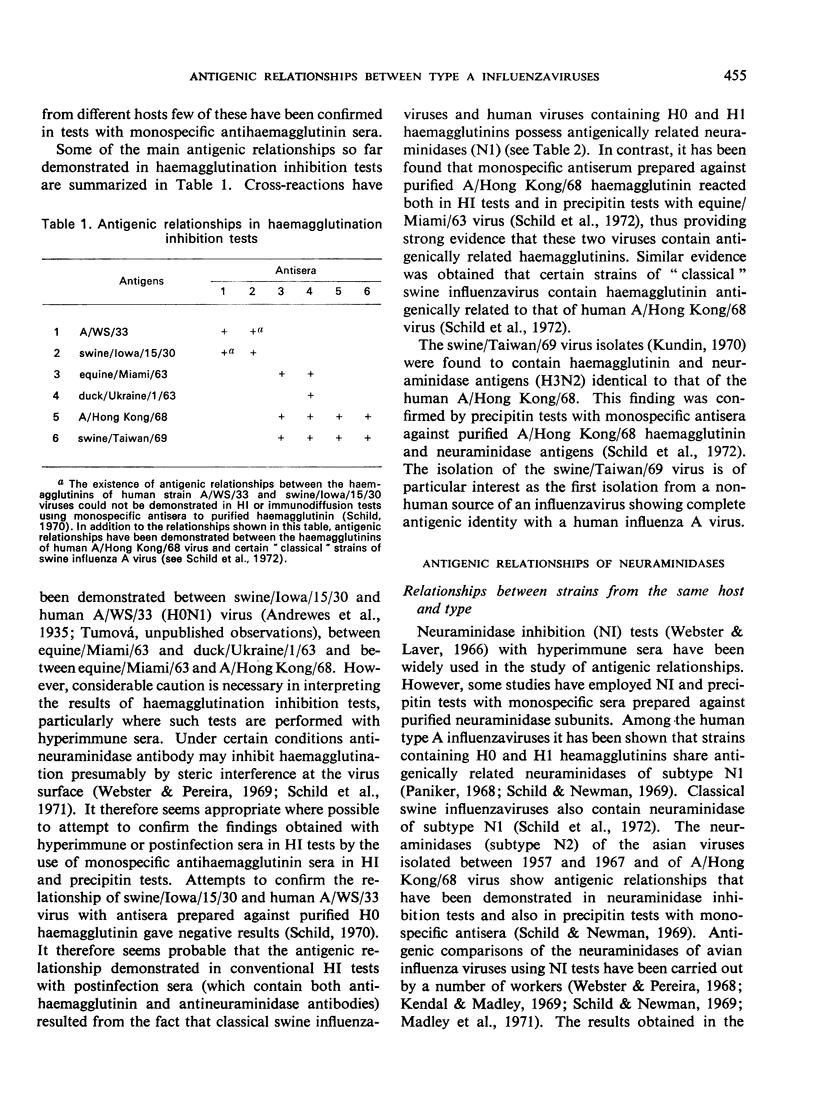
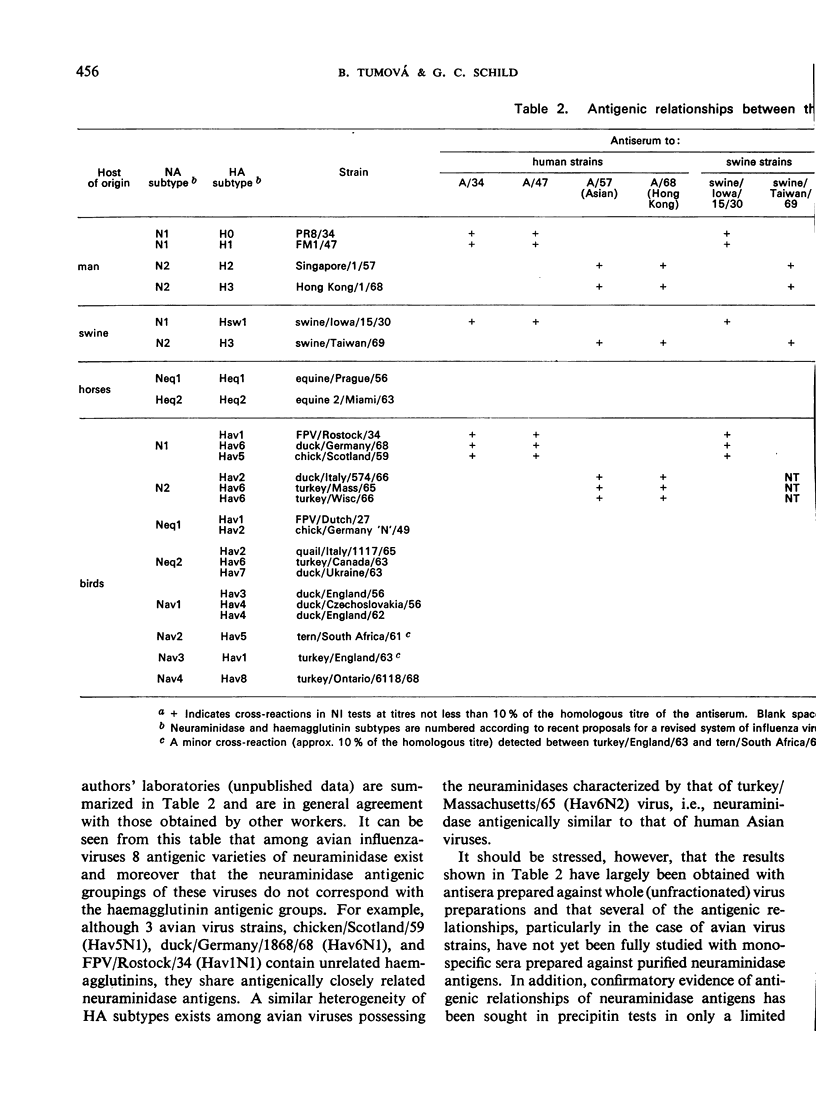
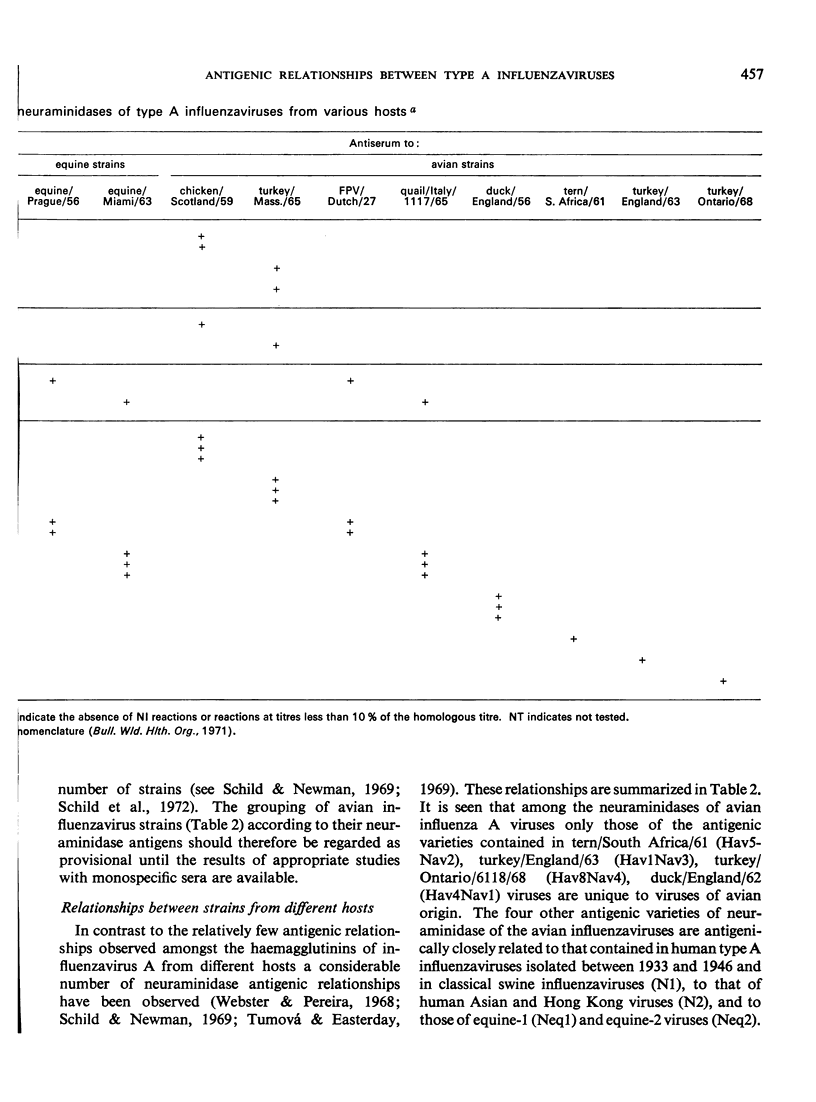
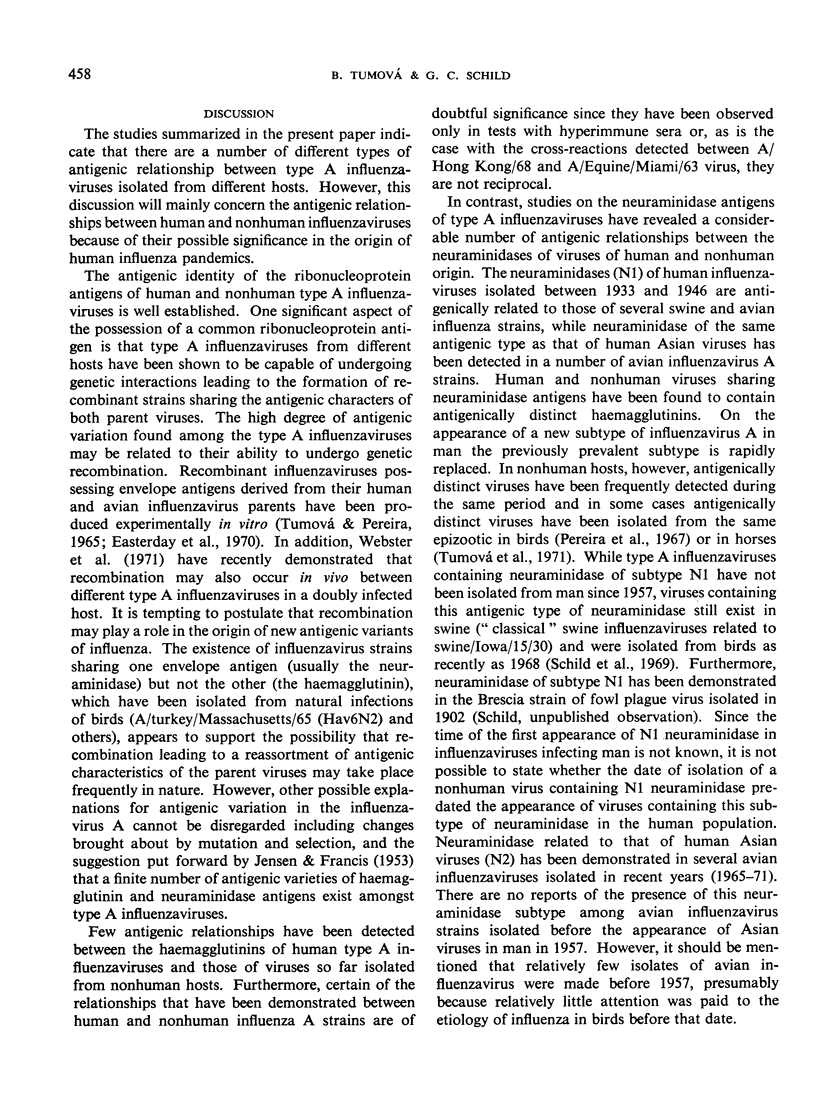
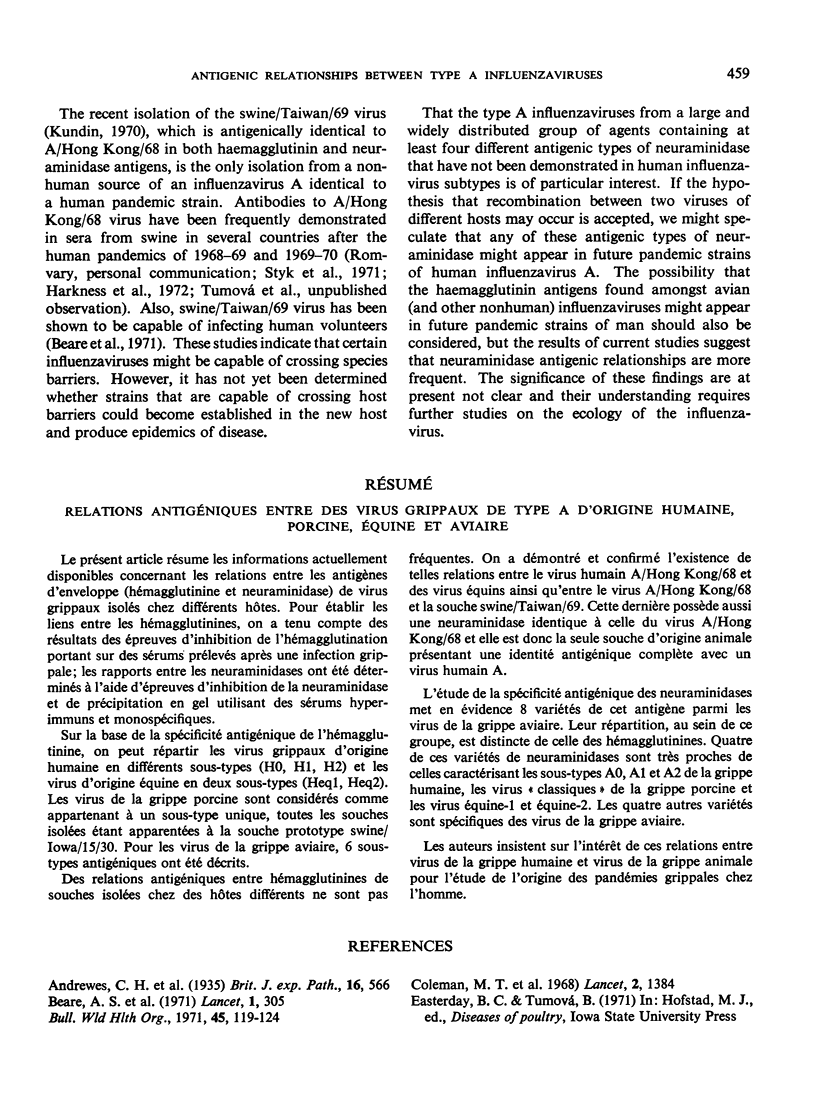
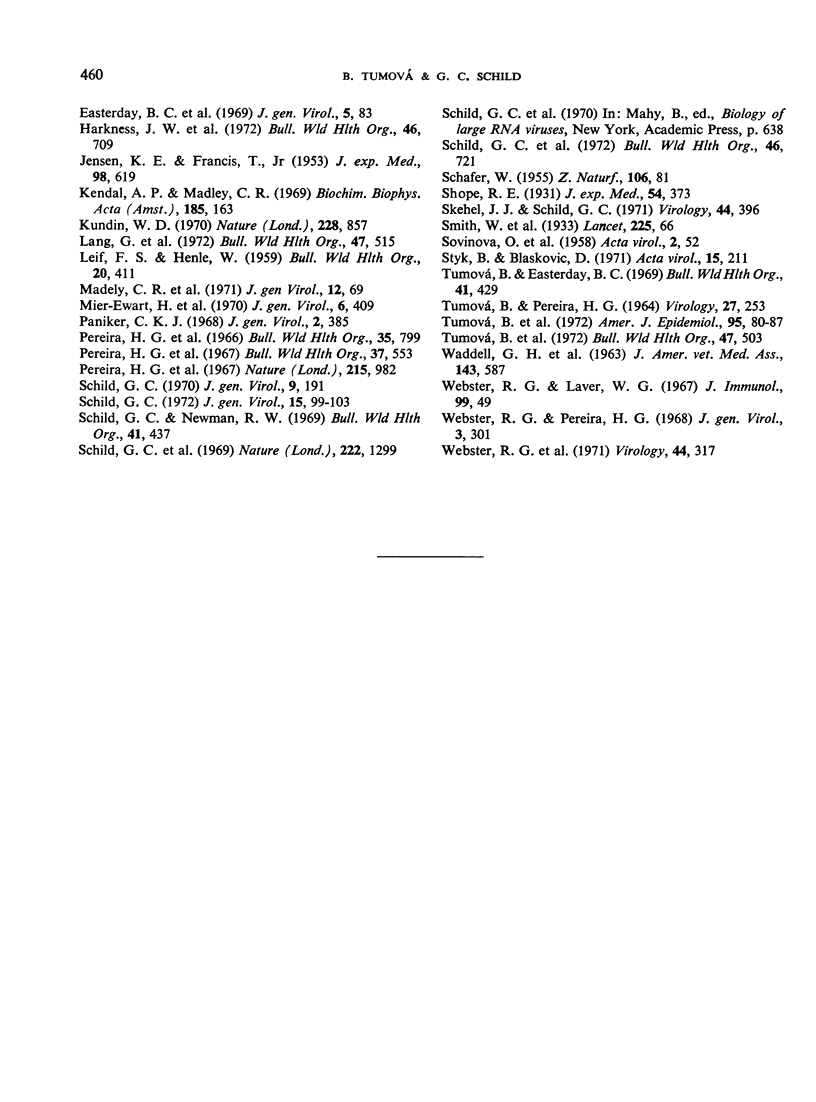
Selected References
These references are in PubMed. This may not be the complete list of references from this article.
- Beare A. S., Schild G. C., Hall T. S., Kundin W. D. Antigenic characteristics of swine influenza virus closely related to human Hong Kong strain and results of experimental infection in volunteers. Lancet. 1971 Feb 13;1(7694):305–307. doi: 10.1016/s0140-6736(71)91039-7. [DOI] [PubMed] [Google Scholar]
- Easterday B., Laver W. G., Pereira H. G., Schild G. C. Antigenic composition of recombinant virus strains produced from human and avian influenza A viruses. J Gen Virol. 1969 Jul;5(1):83–91. doi: 10.1099/0022-1317-5-1-83. [DOI] [PubMed] [Google Scholar]
- Harkness W., Schild G. C., Lamont P. H., Brand C. M. Studies on relationships between human and porcine influenza. 1. Serological evidence of infection in swine in Great Britain with an influenza A virus antigenically like human Hong Kong-68 virus. Bull World Health Organ. 1972;46(6):709–719. [PMC free article] [PubMed] [Google Scholar]
- JENSEN K. E., FRANCIS T., Jr The antigenic composition of influenza virus measured by antibody-absorption. J Exp Med. 1953 Dec;98(6):619–639. doi: 10.1084/jem.98.6.619. [DOI] [PMC free article] [PubMed] [Google Scholar]
- Kendal A. P., Madeley C. R. A comparative study of influenza virus neuraminidases, using automated techniques. Biochim Biophys Acta. 1969 Jul 8;185(1):163–177. doi: 10.1016/0005-2744(69)90292-7. [DOI] [PubMed] [Google Scholar]
- Kundin W. D. Hong Kong A-2 influenza virus infection among swine during a human epidemic in Taiwan. Nature. 1970 Nov 28;228(5274):857–857. doi: 10.1038/228857a0. [DOI] [PubMed] [Google Scholar]
- LIFE F. S., HENLE W. Methods and procedures for use of complement-fixation technique in type- and strain-specific diagnosis of influenza. Bull World Health Organ. 1959;20(2-3):411–420. [PMC free article] [PubMed] [Google Scholar]
- Meier-Ewert H., Dimmock N. J. Studies on antigenic variations of the haemagglutinin and neuraminidase of swine influenza virus isolates. J Gen Virol. 1970 Mar;6(3):409–419. doi: 10.1099/0022-1317-6-3-409. [DOI] [PubMed] [Google Scholar]
- Paniker C. K. Serological relationships between the neuraminidases in influenza viruses. J Gen Virol. 1968 May;2(3):385–394. doi: 10.1099/0022-1317-2-3-385. [DOI] [PubMed] [Google Scholar]
- Pereira H. G., Lang G., Olesiuk O. M., Snoeyenbos G. H., Roberts D. H., Easterday B. C. New antigenic variants of avian influenza A viruses. Bull World Health Organ. 1966;35(5):799–802. [PMC free article] [PubMed] [Google Scholar]
- Pereira H. G., Rinaldi A., Nardelli L. Antigenic variation among avian influenza A viruses. Bull World Health Organ. 1967;37(4):553–558. [PMC free article] [PubMed] [Google Scholar]
- Pereira H. G., Tumova B., Webster R. G. Antigenic relationship between influenza A viruses of human and avian origins. Nature. 1967 Aug 26;215(5104):982–983. doi: 10.1038/215982a0. [DOI] [PubMed] [Google Scholar]
- SOVINOVA O., TUMOVA B., POUSKA F., NEMEC J. Isolation of a virus causing respiratory disease in horses. Acta Virol. 1958 Jan-Mar;2(1):52–61. [PubMed] [Google Scholar]
- Schild G. C., Brand C. M., Harkness J. W., Lamont P. H. Studies on relationships between human and porcine influenza. 2. Immunological comparisons of human A-Hong Kong-68 virus with influenza A viruses of porcine origin. Bull World Health Organ. 1972;46(6):721–728. [PMC free article] [PubMed] [Google Scholar]
- Schild G. C. Evidence for a new type-specific structural antigen of the influenza virus particle. J Gen Virol. 1972 Apr;15(1):99–103. doi: 10.1099/0022-1317-15-1-99. [DOI] [PubMed] [Google Scholar]
- Schild G. C., Newman R. W. Immunological relationships between the neuraminidases of human and animal influenza viruses. Bull World Health Organ. 1969;41(3):437–445. [PMC free article] [PubMed] [Google Scholar]
- Schild G. C., Pereira H. G., Schettler C. H. Neuraminidase in avin influenza A virus antigenically related to that of human A0 and A1 subtypes. Nature. 1969 Jun 28;222(5200):1299–1301. doi: 10.1038/2221299a0. [DOI] [PubMed] [Google Scholar]
- Schild G. C. Studies with antibody to the purified haemagglutinin of an influenza Ao virus. J Gen Virol. 1970 Dec;9(3):191–200. doi: 10.1099/0022-1317-9-3-191. [DOI] [PubMed] [Google Scholar]
- Shope R. E. SWINE INFLUENZA : III. FILTRATION EXPERIMENTS AND ETIOLOGY. J Exp Med. 1931 Jul 31;54(3):373–385. doi: 10.1084/jem.54.3.373. [DOI] [PMC free article] [PubMed] [Google Scholar]
- Skehel J. J., Schild G. C. The polypeptide composition of influenza A viruses. Virology. 1971 May;44(2):396–408. doi: 10.1016/0042-6822(71)90270-4. [DOI] [PubMed] [Google Scholar]
- Styk B., Sabó A., Blaskovic D., Masárová P., Russ G., Hána L. Antibody against Hong Kong influenza viruses in pigs. Acta Virol. 1971 May;15(3):211–219. [PubMed] [Google Scholar]
- Tumova B., Easterday B. C. Relationship of envelope antigens of animal influenza viruses to human A2 influenza strains isolated in the years 1957-68. Bull World Health Organ. 1969;41(3):429–435. [PMC free article] [PubMed] [Google Scholar]
- Tumova B., Easterday B. C., Stumpa A. Simultaneous occurrence of A-equi-1 and A-equi-2 infleunza viruses in a small group of horses. Am J Epidemiol. 1972 Jan;95(1):80–87. doi: 10.1093/oxfordjournals.aje.a121373. [DOI] [PubMed] [Google Scholar]
- Tumova B., Pereira H. G. Genetic interaction between influenza A viruses of human and animal origin. Virology. 1965 Nov;27(3):253–261. doi: 10.1016/0042-6822(65)90104-2. [DOI] [PubMed] [Google Scholar]
- Tumová B., Isacenko V., Easterday B. C. A new subtype of avian influenzavirus: antigenic characteristics of envelope antigens. Bull World Health Organ. 1972;47(4):503–506. [PMC free article] [PubMed] [Google Scholar]
- WADDELL G. H., TEIGLAND M. B., SIGEL M. M. A NEW INFLUENZA VIRUS ASSOCIATED WITH EQUINE RESPIRATORY DISEASE. J Am Vet Med Assoc. 1963 Sep 15;143:587–590. [PubMed] [Google Scholar]
- Webster R. G., Campbell C. H., Granoff A. The "in vivo" production of "new" influenza A viruses. I. Genetic recombination between avian and mammalian influenza viruses. Virology. 1971 May;44(2):317–328. doi: 10.1016/0042-6822(71)90263-7. [DOI] [PubMed] [Google Scholar]
- Webster R. G., Laver W. G. Preparation and properties of antibody directed specifically against the neuraminidase of influenza virus. J Immunol. 1967 Jul;99(1):49–55. [PubMed] [Google Scholar]


